
with articles on computer applications in photography.
|
The GPD Pocket "...or are you just glad to see me?" |

|
Back to the Photo Bytes section, with articles on computer applications in photography. |
|
Contents New or updated sections are marked with date in color, like 2017/01/03 | |||
|
| ||
|
There are multiple reasons why you may need a Pocket computer. Not a tablet or smart phone, mind it, but a real computer, running the same operating system as your desktop and/or laptop, with the same applications, using the same data sets.
| The most common reason is that you don't have to decide whether to take a computer along every time you leave home. You don't do that with glasses or underwear, right? (Well, maybe a few people do.)
| .r.jpg)
| For this reason and many others I need one. In the early Nineties I used the HP Palmtops, capable of running DOS and some DOS applications, and I liked them a lot, in spite of all limitations. Then I missed the train with the early Asus Eee releases, and then it was too late: the Eee evolved into a line of cheap and uninspiring netbooks, disappointing from any angle. Too bad. Then, in October, 2016, a Chinese company GPD (Game Pad Digital) released a pocket-sized GPD Win, which was basically a Windows 10, pocket-sized computer pretending to be a game console, inclusive with built-in game controls. This was a crowd-funding project on Indiegogo. The specs were rather modest (for example: 64 GB of solid-state disk drive; obviously, an Atom processor). but the campaign was successful. You can still buy the newest, improved version at $350 or so. After that, the GPD people decided to go all the way and bring to the market a "real" pocket-sized Windows computer, a rather upscale version. Another crowd-funding campaign brought $3.5M of seed money, and last June they started shipping out the GPD Pocket (a.k.a. GPD Mini), soon after that moving on to the open market. Then I read about it and got interested. No, a Pocket computer will not replace my aging laptop. It should ease the transition, though, and also provide me with some other capabilities I need when out of home and without a larger computer. The Pocket is being sold on Amazon by a number of vendors, with U.S. prices varying, roughly, between $550 and $600. I ordered mine from GearBest in China; shipped from Beijing it arrived after a little more than two weeks. So here it is: the GPD Pocket in all its miniature cuteness: facts, hard data, my impressions, comments and complaints. With the footprint of 11×18 cm (7¼×4¼") and 19 mm (¾") thick, the device easily fits into a jacket's breast inner pocket. Importantly, it also will fit in "tablet pocket", common in camera bags. The smallest of those are designed to accommodate 7" or 8", 16:9 screens. They also offer adequate padding, therefore the computer is getting a free ride and needs no protection of its own. Actually, with the rigid a strong clamshell, it will have better chances of survival than a tablet, if something happens.
The body construction is first-class. A strong yet lightweight magnesium (or aluminum?) alloy is used, and there is enough of it. No flexing, bending, or popping whatsoever. | The display hinge provides just the right amount of friction resistance (at the same time smartly housing some cooling vents). All is neat and clean, understated elegance.
| 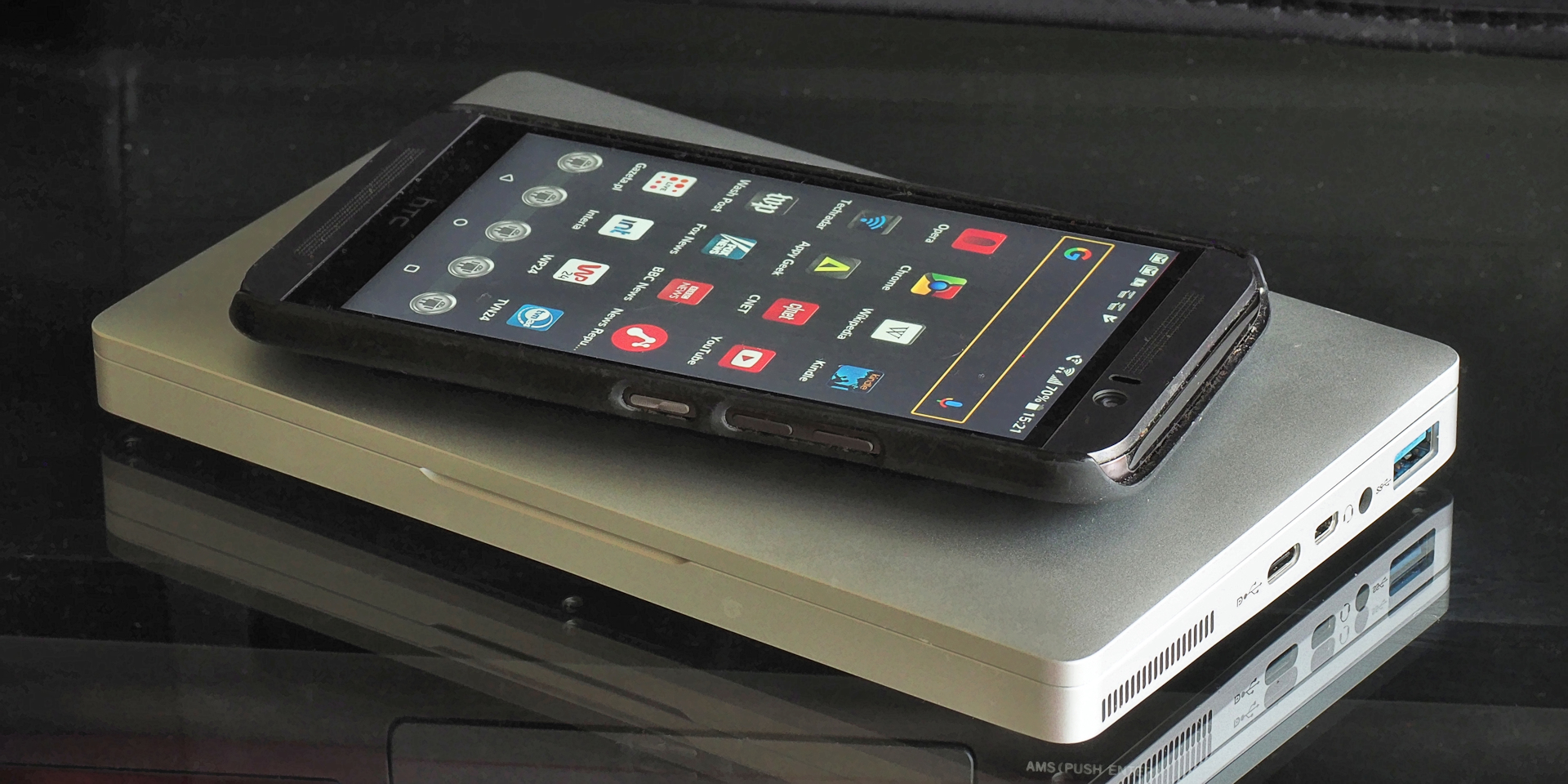
|
Refreshingly, the outer surfaces are not broken by manufacturer's logo or some sticker decals; the only semi-exception is some barely visible text on the bottom side; mostly the required regulatory information.
The display is 151×94 mm, 7 inches (178 mm) diagonally, with a resolution of 1920×1200 pixels — slightly higher than Full HD. Therefore the aspect ratio is 8:5, a format recently gaining some popularity and, according to some (myself included), more practical than the somewhat more elongated, most popular, 16:9. Just for your entertainment, here is how images with most common aspect ratios will look on the Pocket's screen ("fit to screen" mode, preserving the image aspect). Purple shows the letter-boxed parts of the native display. | |||||
 4:3 |  3:2 |  8:5 |  16:9 |
|
With this size and resolution, the resulting pixel density of the Pocket's display is 12.7 pixels per millimeter or 323 per inch. Many reviewers and some sellers quote different PPI values; some even stubbornly claim the vertical screen resolution of 1080 pixels. Both groups are wrong. The display panel is of the In-Plane Switching (IPS) type, upper shelf, used by Apple, Samsung, and some others in their top-tier devices. This kind is known for good colors and good off-axis viewing; no corner-cutting here.
| 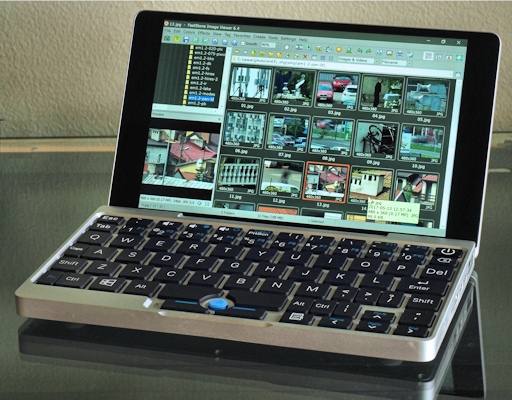
| Out of the box, the display is set for a generally pleasing viewing experience, providing, on my patch target, too much contrast in mid-tones at the expense of detail separation at both ends. Still, at least the saturation is not overdone, like in many smart phones, tablets, and big-screen TVs. This is a touch-sensitive display. Generally, I dislike these in laptops, but in this particular case I don't, especially when using the computer without a real mouse, just with the eraser stick. There is no pressure sensitivity, but it wouldn't be useful in this form factor anyway.
|
Just for the record: the screen is covered with Corning Gorilla Glass 3, another supposedly hot feature I have no clue about.
Now, bad news. This is a glossy display, no anti-glare finish, a kind I really, really hate. Their main advantage seems that contrast and saturation seem higher when on a store display; in practical use I find them most troubling. The last thing I want to see in the morning is the reflection of my own mug, superimposed on whatever I'm viewing. A remedy, partial at least, may be application of a screen protector sheet. There was even one included in the box. It did not, however, reduce the glare like the proper treatment does, so I removed it after a few days. (A good example of effective anti-glare finish is the Dell XPS series, non-touch version.) For more on this, see Accessories.
Here are some benchmark results, to compare the GPD Pocket against some traditional laptops of various vintages:
The Performance Benchmark (PassMark) Version 9 results are shown in the table below. For work, I often run applications using lots of CPU power (mostly floating-point) on a single thread, single processor. The last column shows how much time did it take to process a full day of U.S. air traffic (about 50 thousand flights).
|
| |||||||||||||||||||||||||||||||||||||||||||||||||||||||||||||
|
This is actually better than I expected for a tiny, low-power device. The CPU Mark for a seventh-gen i7 is just 2.2× better than what Mini scored (and I would expect 3× for the new, eight-generation i7-8550, used on some top-of-the-line light laptops). This is not inconsistent with the 2.6× increase in speed which I'm getting in my own applications (the last column).
The Disk Mark obtained for the GPD using its internal eMMC was 737, not much above the 601 reported for my old Alienware with its spinning, mechanical drive. Because with the Pocket I will have to depend a lot on external drives, I did some read/write benchmarks with those, too. The results are quite interesting.
|
|
Surprise! The external Samsung T5 SSD scored (3221) more than four times higher than the internal eMMC (737). This makes using external drives not a necessity (forced on us by limited internal storage), but rather a free choice (driven by higher speed of the external medium).
Actually, we may look at it from the opposite angle: it is the internal storage which is so slow. The external T5, however, is not far behind the internal unit in LG (4068, also by Samsung), and this is not too shabby. Also, note that the one-terabyte Western Digital mechanical drive got a better, if only slightly, benchmark (786) than the internal eMMCs (737). (I've run that benchmark four times and on two WD drives.) The USB sticks came last (418 and 574), but not far behind the eMMC (737).
| 7,000 mAh, 26 Wh Lithium-Polymer (Li-Po) battery. The Li-Po chemistry is rather upscale, a plus. The battery is also quite large, using about half of available space in the main body of the computer. The claimed battery life estimate of 12 hours is overly optimistic. Realistically, I'm getting six to seven hours of mixed use, which I consider a very good result. There is no dedicated power-in socket. Instead, the Pocket uses its sole USB Type C receptacle for powering/charging. If you need the Type C port for data interface, look for the right adapter. With that, the port will serve multiple devices at a time, still supplying the computer with power from the charger. The included wall converter is much smaller than power bricks, still used with most laptops. It supports the Power Delivery protocol, negotiating with the powered device about the voltage to be supplied and maximum current. This particular one provides three options:
It remains unclear, which of these options does the Pocket use. A plain, 5 V USB power supply can also be used, as long as it provides enough juice, best when the computer is off when charging. While even the most limited, 500 mA outlet will recharge the battery (albeit slowly) when the computer is asleep, things go downhill if you insist to use it while charging: a 1 A outlet will barely keep up with power usage, and only 2 A will actually make some difference. Battery charging, with the included charger at least, is quite fast: 128 minutes from 12% to 90%. For a device of this size, the GPD Pocket set of ports is very nice, not worse than in some ultralight laptops. Still, it may be not quite enough for many, perhaps most, users. Not without a port hub, that is. |
|
The ports are as shown in the picture, left to right:
The headset and HDMI socket have their own uses; either you use them for their designated services or you don't use them at all. This leaves only the USB A and C ports re-assignable to any other purposes. The Type C port, however, is most of the time used for power supply, while the Type A one will, if you follow my advice, be occupied by the semi-permanent USB stick drive. This means we have not a single socket left to hook up anything else we may need: another external drive (backups!), scanner, or memory card reader. Not unless we use a hub (a.k.a. multi-port adapter). There are many of these on the market, widely differing in practicality, quality, and price. Some come on a short cable, others have the male USB Type C plug mounted directly on the body. Avoid that type, as they will block the other ports, or the cooling vent, or both. Actually, if the other ports remain unobstructed, then what we really need is a hub with two or three USB Type A sockets, one incoming (charging) USB Type C and, possibly, a reader for SD and/or Micro SD cards. It took me some time to find one on Amazon; see below. Things look good here; no corner-cutting:
The keyboard in GPD Pocket is a mixed job. It is the chiclet type, but a good chiclet, like in better ultralights (comparable to the Dell XPS 13). The keys are relatively large, well-spaced (except for key clusters, see below), with a good tactile feedback and a generous, for this type at least, travel distance of 1.3 mm. Only when using the Pocket did I realize how much I've got used to backlit keys, missing here, probably for energy efficiency reasons. I can't argue with that. But I can, and will, argue about some other design issues. Why wasn't a brighter white used to mark the keys? Or, at least, bold letters? Why the function keys are marked with in soma dark camouflage color, invisible in any less than bright light? And then things get worse. Looks like every time the keyboard designers were running out of space, they would go into panic mode and do something really strange. |
|
Some of the changes just could not be avoided, whether we like them or not. Five keys from the far right had to migrate somewhere, and the only space available was in the top row. Tough luck. Some others, though, seem quite arbitrary. For example, while most keyboards have a wider [Backspace] below a narrow [Delete], this one has a wider [Delete] below a narrow [Backspace]. There must have been a reason, but I can't see it. Also, the F1-F12 function keys, heavily used in many applications for some quick-access functionality, are now accessible by holding down the [Fn] key; some require two hands. This could be greatly helped by making the [Fn] key sticky; unfortunately, Windows allows that for all special keys except this one. I'm afraid that any changes involving the [Fn] key must be done on the BIOS level, as it does not generate a scan code for Windows to use, but modifies the codes sent by other keys. This is also why all keyboard remapping programs (those I know, at least) leave that key alone. The keyboard was, possibly, chosen from existing designs, offered by an external supplier, but it is still GPD who is responsible for the final outcome. I hope the Pocket line will stay on the market, and in the future versions the keyboard will be revised. On the other hand, some of the criticism regarding the keyboard is just ridiculous. For example, about being unable to touch-type on it. C'mon, this is an undersized, chiclet keyboard, not a pony! The bottom line is that, while I find the keyboard mildly irritating, I can live with it (after two weeks of use, as of this writing). It is a minor nuisance rather than a major problem. Update of January 3: after a month of quite heavy use, I came to terms with this keyboard. At this stage, the worst thing about it is the function key problem, mentioned above. The GPD Pocket has a built-in pointing device to move the cursor around: an eraser-tip joystick at the bottom of the keyboard, with two mouse buttons below it. While in the Nineties this was the most common solution, it has been largely replaced by touchpads, although you can still see it in quite a few laptops. This one is no better and no worse than ones I've used over the years. It can be useful from time to time, being more precise than the touch screen (but much slower). Obviously, whenever I can, I'm using a real mouse with the Pocket; the Bluetooth connection is working just fine. More on this in the Accessories section. This computer comes with full, international edition of Windows 10 Home. In a very welcome move, Microsoft allows to distribute this version at no cost for computing devices with displays smaller than 10 inches (diagonal). There is also a version of Pocket with Ubuntu GNU Linux preinstalled, but I never tried it. Another option is to try Ubuntu out without installing it on your computer, using a bootable USB drive. While no Windows restore medium is provided in the package, the drive image can be downloaded from the GPD support area, already customized for this particular hardware (I think it's mostly device drivers). You can also create a bootable recovery USB drive of your actual configuration, but the process, as simple as it is, sometimes takes obscene time. It took me three hours, and I've read about overnight sessions, a well-known bug/feature of Windows for some time now. Unlike many computers, the Pocket does not come loaded with piles of trashware. That's a blessing, taking into account the limited amount of internal storage; every megabyte counts. Another layer of software, invisible to mere mortals, is the BIOS (Basic Input/Output System). It deals with things programmers take for granted, making sure that various versions of hardware properly understand the software (and that it runs at all); it also knows how to load the system from disk when the computer is turned on, and how to start it. There are dozens common versions of BIOS, each for a given group of processor-motherboard combinations; otherwise we would need a different flavor of Windows (or UNIX, or whatever) for each. The Pocket uses the BIOS by American Megatrends, specific to just this computer. It was updated at least twice after the original, and I was happy to see that I received the latest Version 5.011 of August 7, 2017, so I don't have to upgrade it myself. The upgrades, among others, addressed reported problems with low-battery boot and with a somewhat erratic fan behavior. |
|
In the box The Pocket comes with the wall-plugged charger described above and a proper (A-to-C) USB/power cable, 3 m (10 ft) long. There was also a screen protection sheet in the box. At that time, GearBest was also throwing in some freebies (they probably still do). One was a port replicator: plugging into USB Type C port and providing a Type A one, slots for SD and Micro SD cards, and another USB Type C. The device is not very useful, as what you really gain is just one Type A port and card readers, in exchange for the lost (blocked) HDMI output. The other freebie is a fitted leather case, quite nice. I'm not sure, though, how much I'm going to use mine. The third thing was not in the package and I don't even remember what it was supposed to be. As always, you need a few extra accessories to make the computer usable. Mouse, of course, a Bluetooth one This will keep ports available for other uses. I've been using two such mice on this computer; both are rechargeable and neither gave me any connection problems.
|
Logitech Ultrathin T630 ($46) is beautifully designed and has a touchpad instead of the wheel.
There is a serious problem, though: the mouse often does not register button clicks: there is a tactile and visible feedback, but no mouse event detected. Obviously, this is about the way I hold the mouse, but I don't care: the thing just isn't working for me. Scrolling by the touchpad is also erratic. Too bad. Fenifox Ultra Thin Mouse ($20) is even slimmer than the T630, but longer; it also has an actual scrolling wheel. The tracking is better, clicks more positive and predictable, and so is scrolling.
| 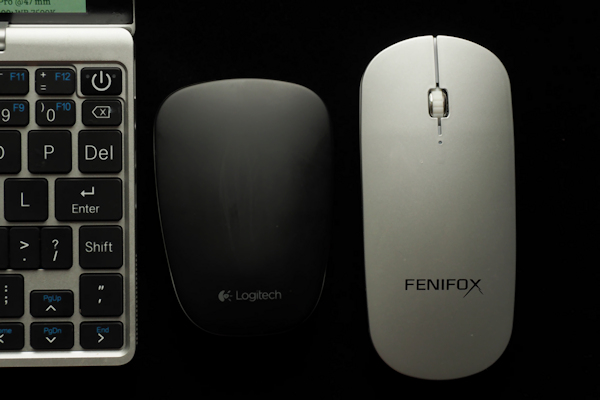
The Bluetooth mice: Logitech and FeniFox
| External storage, and plenty of it! With the GPD Pocket this is not just the matter of backups or long-term archiving. Most of the users will have to resort to external storage for day-to-day operations. And I think you may need all three kinds of that storage.
| A few USB memory sticks While being the slowest kind, they add practically nothing to the size or weight of the system, so one can be plugged in all time. 128 GB is a handy size. Samsung ($40) and SanDisk ($26) have models similar in form factor, performance, and price. There are reports about the SanDisk version getting hot when writing large amounts of data. I have seen this to happen, but haven't experienced any failures. A larger option is a 512 GB by PNY ($140). It extends about 40 mm out of the socket, but at this capacity you cant' avoid it. Yet. Again, it got uncomfortably hot writing 300 GB of data, but is still working OK aftrt three monyhs of use.
| 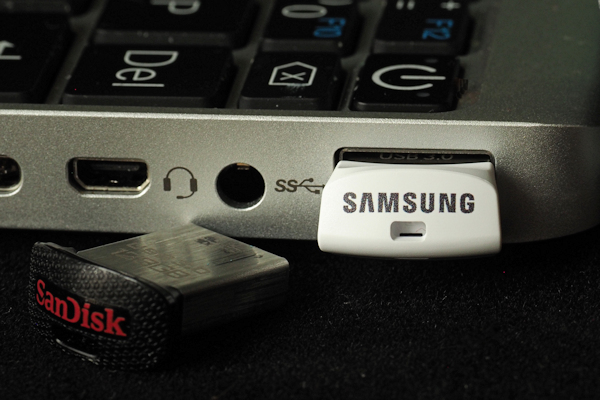
128 GB USB memory sticks by SanDisk and Samsung
| An external Solid State Drive (SSD). Samsung T5 (512 GB, USB 3.1) sells at $170, the same price per gigabyte as their USB stick, but is much faster. Models up to 2 TB are available at this time. Actually, on this computer the T5 is as fast as the internal eMMS, therefore I would recommend it as a working storage for I/O-intensive applications.
| 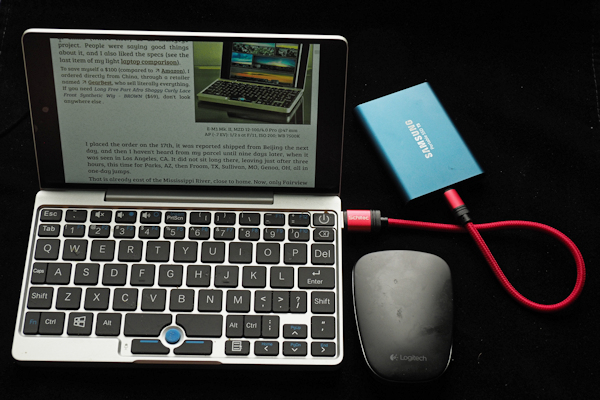
512 GB Samsung T5 external SSD
| An external, mechanical hard drive These are more affordable as high-volume archival backup storage. Western Digital My Passport 1 TB (1024 GB!) and many others sell below $60, which is a steal. On the Pocket they are almost as fast as external SSDs (while being six times cheaper per gigabyte), so the only disadvantage is the larger physical size and weight. While the current My Passport drives may be the ugliest I've seen, they are inexpensive, reasonably fast, and reliable.
| 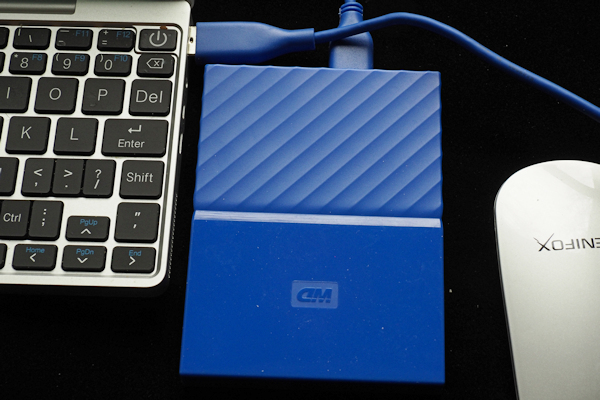
WD My Passport 1 TB external HD
| Some kind of cloud storage may also be an option, but I still don't have an appropriate synchronization procedure developed for that, so I'm not using it. We need one plugging into the sole Type C port on the Pocket, and tethered (as opposed to a rigid, direct connection), ideally providing two USB Type A ports, an SD card reader and, importantly, a Type C Power Delivery port with power in. The hub by Lasuavy, is nicely made and offers the basic options as enumerated above (including two USB 3.0 Type A ports and adding a micro-SD reader).
Update of February 1: Originally, the power-in feature of this hub did not work for me. Then I found out that it will — if the hub is first connected to the (working) power supply, and only then to the Type C port in the computer. While this behavior seems to be common among Type C hubs, a proper warning sign would be nice. An anti-glare (matte) screen protector The one from BROTECT is better than anything I have seen yet, and I'm recommending it highly. BROTECT is a German company; they sell screen protectors made of thin, flexible glass (not plastic), for all kinds of screens. On Anazon, they offer two versions for the GPD Pocket: glossy and matte. I've ordered the latter. This thing is expensive ($15 for a two-sheet pack), but it is worth every penny. Having used maybe three similar products in the past, I'm not an expert, but I can say this is the best aftermarket, anti-reflective laminate I have yet used or seen. It suppresses reflections effectively, at the same time not affecting the image — brightness, contrast, saturation and detail are not degraded. If anything, my pictures look better now, like large-format prints after switching from glossy paper to semi-matte. This may be wishful thinking, but they do. Seriously. I was also unsure how will the extra layer affect the touch screen sensitivity. Good news again, things are working nicely, and I like the feel now more than before. Last but not least: the dreaded air bubbles. I got a few; some gentle persuasion made them go away. Except one, 2 mm across, which simply refuses. Luckily, it is located in the left bezel, outside of the image area, but I will still keep working on it. Microsoft Wireless Display Receiver This is a $50 dongle you plug into virtually any HD, big-screen TV as already discussed. As Windows 10 supports Miracast on this computer, I could use any compatible receiver instead. The Microsoft solution, however, gets highest notes in most comparisons, so I chose it. I've been using the Microsoft's version for two months now (as of this update). It works OK (at least with resolutions up to 1080p at 30 FPS: no stutter or excessive lag, although the TV image is about ¼ of a second behind. This may, however, become a problem in games, and that's when wired HDMI may come handy. Occassionally, the receiver shows problems: erratic screen refresh, with pieces delayed or pixelated, and I'm talking about just desktop display, not some video with high data rate. This seems to be common, and it goes away after a restart (unplugging both ends from the TV). The receiver was never able to establish a connection with my friend's Dell XPS 13. as much as we kept trying. Both devices see each other, start the process, give up. I also tried a Miracast receiver, branded as AnyCast (and sold on Amazon under a dozen other names, too). No luck, symptoms like above, on both computers. Update of 2017/12/12: The AnyCast was able to establish connection between the Pocket and a Sony HDTV, initially with a a lag of about one second. After a few minutes this increased to more than five seconds, with an occassional hiccup, only to freeze entirely soon after that. Another failure. The Microsoft receiver works just fine with the same setup. Anyway, for playing games you will still need an HDMI cable, Micro to full size. USB cables: never enough of those Basically, you need two types: A-to-C and C-to-C (male connectors on both ends), in lengths varying from 30 cm to 3 m (1 to 10 ft). To avoid compatibility or performance issues, make sure they support the USB 3.0 standard at least. A quote, slightly rephrased: "USB 3.1 is capable of data transfer speeds up to 10Gbps if your USB host connection, cables, and device all support USB 3.1. It also known as USB 3.1 Gen 2 (10Gbps). USB 3.0 is capable of data transfer speeds up to 5Gbps. It is also known as USB 3.1 Gen 1 (5Gbps). USB 3.1 is backwards compatible with USB 3.0 and USB 2.0." If you need to know more on USB 3.1, see, for example, an article on Digital Trends. Also, get a male-to-female Type C, angle connector or two. These come very handy. The GPD Pocket mini-laptop is a little wonder of technology, a most enjoyable and useful device, but only if you really need it, or can find a good use for it, or are a computer technology freak like myself. Any one of those three conditions would justify the purchase, two would be a compelling reason, and three will make it an absolute necessity. It will not replace a regular laptop, even a small one, and it is not trying to. You will not be able to use it as your primary computer. But it may be at hand in many situations in which normally you wish you had a computer with you. The designers did a very good job within the self-imposed (or perhaps market-imposed) limitations of size and price, and the execution of the design is first-class. I hope GPD will follow up with a more upscale model, and I would be willing to pay $300 more for it. The most significant upgrade would be more of internal storage: at least 500 GB. Backlit keyboard would be nice; nicer than I would have ever thought. A slight rearrangement of the keyboard layout will make many people happy. too. Well, we will see. At the time (November, 2017) I'm happy with this computer, enjoying it a lot. I'm going to Poland (again!) in December, and taking it along. We will see how it will prove itself. Update of 2019: I'm glad I did that. My "real" laptop died while I was there, and for a month the Pocket became my only computer, with a large-screen TV as monitor, and with the dead laptop's drive housed in an external enclosure. This worked better than I expected; I was even able to use the C++ CodeBlocks development environmrnt! Another Chinese company, One Netbook, followed with a GPD Pocket look-alike, named One Mix Yoga. You have to look really close to see that this is a different device.
| It has five advantages over the Pocket, which I'm listing here in deceasing order of (my sobjective) importance:
| 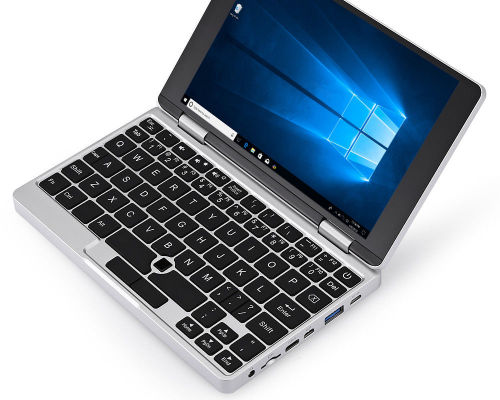
| The top two of these features would have made the One Mix Yoga a strong contender, if not for one unfortunate design decision: using the Intel Atom x5-Z8350 CPU, considered to be "much slower" than the x7-Z8750, used in the Pocket. Its CPUBench (at base clock rate) is just a third behind, but being less power-efficient the cip will usually be throttled down at lower speeds. Add to that the slower, single-channel memory, plus some other stuff I may not know about, and we may get some visible drop in performance, subjectively enhanced by our expectations. Because of these performace isssues (whether real or perceived), One Mix Yoga ever challenged the original GDP Pocket for its top-dog mini status. Over a year of using my GPD Pocket, I exerienced one hardware failure: the keyboard. One day some keys just stopped responding. The GPD technician reacted swiftly, asked whether I'm willing to replace the keyboard myself, and had a new one on its way the next day. Air express from China to Poland (where I am staying now) took four or five days. My stepson did a splendid (and quite entertaining), one-hour replacement job, and I was back in business. Too bad that, before contacting the support, I followed a piece of advice from a GPD forum and restored Windows to the original (factory) state. Having to tweak Windows back to my liking, and to re-install and re-configure my applications, took a long time. I've also seen hundreds of complaints about the Pocket discharging the battery after being put into sleep state. Yes, I have experienced that too, but the problem is not with the hardware: the Windows Connected Standby and Modern Standby features do not work quite right (they never did), another example of excellence Microsoft is so admired for. Use a Web search to find out how to disable these features. Given the scale of the problem, GPD should, I think, add a brief explanation to their support materials, maybe even regisstry patches to do/undo the modifications needed.
| |||||||||||||

|
Back to the Photo Bytes section, with articles on computer applications in photography. |
| Home: wrotniak.net | Search this site | Change font size |
| Posted 2017/11/21, last updated 2019/04/08 | Copyright © 2017 by J. Andrzej Wrotniak |